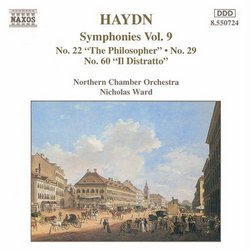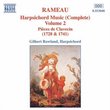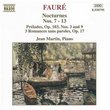| All Artists: Franz Joseph Haydn, Nicholas Ward, Northern Chamber Orchestra Title: Haydn: Symphonies Nos. 22, 29 & 60 Members Wishing: 0 Total Copies: 0 Label: Naxos Original Release Date: 1/1/1995 Re-Release Date: 3/21/1995 Genre: Classical Styles: Chamber Music, Historical Periods, Classical (c.1770-1830), Symphonies Number of Discs: 1 SwapaCD Credits: 1 UPC: 730099572422 |
Search - Franz Joseph Haydn, Nicholas Ward, Northern Chamber Orchestra :: Haydn: Symphonies Nos. 22, 29 & 60
 | Franz Joseph Haydn, Nicholas Ward, Northern Chamber Orchestra Haydn: Symphonies Nos. 22, 29 & 60 Genre: Classical
|
Larger Image |
CD DetailsSimilar CDs
|
CD ReviewsExploring the Haydn Symphonies Robin Friedman | Washington, D.C. United States | 03/01/2004 (5 out of 5 stars) "One of the outstanding features of budget-priced CD's is the opportunity they offer the listener to explore music. Thus, Joseph Haydn (1732-1809) wrote 104 symphonies, but most listeners probably have familiarity with a small handful of them. The Haydn symphonies are eminently worth knowing in detail. For some years, Naxos has been in the process of recording all the Haydn symphonies by a variety of orchestras and conductors. By approaching the CDs on a disk by disk basis, the listener can gain better familiarity with individual works than would ordinarily be the case by purchasing a complete set and leaving most of the works to remain unheard.A major feature of Haydn's genius was the variety of musical styles and the diversity of musical purposes he put in his symphonies. This disk of Haydn Symphonies Nos. 22, 29, and 60 illustrates Haydn's inventiveness and creativity in three early symphonies. The symphonies here are performed by the Northern Chamber Orchestra of Manchester, England conducted by Nicholas Ward.Haydn composed his symphony no. 22 in E-flat major, "The Philosopher" in 1764 for Prince Esterhazy at the court of Eisenstadt. This symphony is in an archaic style which is modeled on the late Baroque Church sonata -- with a slow opening movement and slow third movement and fast second and final movements. Much of this symphony bears the traces of church chorales.The most striking feature of "The Philosopher" is its use of brass and winds. In particular, Haydn gives heavy emphasis to the horns and makes great use as well of the English Horn -- a rarity in symphonic music of any era. The first movement features a theme in the horns and English horns over a walking figure in the muted strings and is meditative and thoughtful in character -- altogether music worthy of a philosopher. The horns also play a large role in the rest of the work, particularly in the trio of the minuet and in the lively finale.The symphony no. 29 in E major, was composed in 1765 while Haydn still resided at Eisenstadt. This work is an intimate chamber symphony in what would become the usual symphonic format -- an opening allegro, followed by an andante, a minuet and a presto finale. The unusual feature of this symphony is the emphasis Haydn places on the finale. Most early classical symphonies tend to be weighted toward the opening movement with the finales exhibiting a distinctly lighter touch. In the symphony no. 29, in contrast to the usual pattern, the opening three movements are well-matched in their quiet, subdued themes. But the finale is full of energy and high spirits following the quiet character of the proceeding movements. It is the highlight of the work. I also enjoyed the horn playing in the trio of the minuet.Haydn's symphony no. 60 in C major "Il Distratto", composed in 1774, is of still a different character than the other symphonies on this disk. This symphony derives from incidental music that Haydn composed for a slapstic comedy, called "The Absent-Minded Man" which featured many rather predictable gags about its hero. Haydn's symphony is full of jokes, some of which remain obvious to the modern listener unfamiliar with the play. The most obvious joke occurs in the final movement. After a serious, dignified introduction, the strings stop awkwardly, realizing that they have forgot to tune their instruments, and the music pauses while they tune up. It is an unmistakable touch. Other movements as well feature abrupt changes in instrumentation and in themes, as befitting an absent-minded person and feature as well the interposition of various folk tunes. Through all the heavy-handed humor, the music remains of high quality. Haydn had the great virtue of knowing how to laugh. This symphony remained very popular in Haydn's lifetime and he was called upon to resurrect the score in performances for the Empress of Austria late in the 18th century. The work also remained popular in the 19th century.Haydn was a master composer worthy of the company of Beethoven and Mozart. The music on this CD should help dispel the pictures some may still have of a rather stuffy, conventional "Papa" Haydn. The three symphonies of lovely and varied music on this CD are a wonderful way to explore the Haydn symphonies."
|

 Track Listings (14) - Disc #1
Track Listings (14) - Disc #1

